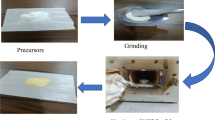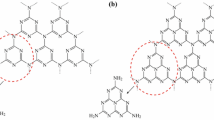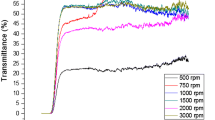Abstract
An electropolymerized film of new eriochrome black T (EBT) doped with carbon nanotubes (CNTs) has been prepared on the surface of indium tin oxide (ITO) in a solution of acetonitrile containing lithium perchlorate (LiClO4) as supporting electrolyte by cyclic voltammetry (CV). The distribution of CNTs in the poly eriochrome black T (PEBT) matrix was studied through scanning electron microscope (SEM) and energy-dispersive X-ray spectroscopy. Their chemistry and electrical properties were determined by CV and electrochemical impedance spectroscopy (EIS). The optical characterization of the composites was made by UV–Vis absorption. The results showed that CNTs nanoparticles were dispersed and co-deposited into the PEBT matrix; the voltammogram of EBT before and after doping with the semiconductor of CNTs present a large difference in the form of recorded cyclic voltammograms. It is noticed that the shape (intensity, potential and number of redox couple) of the cyclic voltamperogram varies with the addition of CNTs; the appearance of new peaks of oxidation and reduction suggests the formation of a new composite material. This confirmed that there is a reaction which develops between the EBT, CNTs and LiClO4. The best distinction of the peaks was obtained during the addition of 0.2 mg of CNTs, leading to increase the conductivity of the PEBT film that forms on the ITO electrode. The images of SEM confirm the presence of CNTs in the composite, which consequently modifies significantly the morphology of the film. The CV study showed redox couples characteristic of poly EBT at 0.6 and 0.5 V. The EIS measurements show that the resistance of the PEBT films decreases with increasing of CNTs amounts. This demonstrates that the inclusion of the CNTs enhance the electrical properties of the polymer. Thus, these composite films can be used in various fields. The optical bandgap decreased generally with increase in content of CNTs compared with PEBT only. This is explained by the introduction of the donor levels in the bandgap of PEBT by the CNTs, this decrease in gap energy is explained by the Burstein–Moss effect.











Similar content being viewed by others
References
Palraj K and Abraham J S 2009 Electrochim. Acta 55 183
Hong Y, Yuanyuan S, Xinhua L, Tang Y and Huang L 2007 Electrochim. Acta 52 6165
Maouche N, Nessark B and Bakas I 2015 Arab. J. Chem. 04 029
Gilissen K, Stryckers J, Verstappen P, Drijkoningen J, Heintges G H L, Lutsen L et al 2015 Org. Electron. 20 31
Küçük A and Torul O 2018 Synth. Metals 237 23
Khshaba P Y, Refat Ali H H and El-Wekil M M 2017 Electroanalysis 29 1
Wei Y, Luo L, Ding Y, Kang Z and Ye D 2014 Bioelectrochemistry 98 70
Wei Y, Luo L, Ding Y, Liu X and Chu Y 2013 Microchim. Acta 180 887
Kalyani S G, Ronald J M, Tony T and Ozma J D 2014 Ionics 20 849
Muhammad S, Nazal M K, Mansha M, Alsharaa A, Jillani S M S and Basheer C 2016 Trends Anal. Chem. 76 15
Hong Y, Yuanyuan S, Xinhua L, Yuhai T, Ailin L, Guangwen L et al 2007 Anal. Sci. 23 677
Chandra U, Gilbert O, Kumara Swamy B E, Bodke Y D and Sherigara B S 2008 Int. J. Electrochem. Sci. 3 1044
Bedoui A, Ahmadi M F, Bensalah N and Gadri A 2009 Chem. Eng. J. 146 98
Geng M, Xu J and Hu S 2008 React. Funct. Polym. 68 1253
Khurana I, Kumar Shaw A, Jitender B, Khurana M and Kumar Rai P 2018 J. Environ. Chem. Eng. 6 468
Gilbert O, Kumara Swamy B E, Chandra U and Sherigara B S 2009 Int. J. Electrochem. Sci. 4 582
Chandra U, Eshwaraswamy B, Swamy K, Gilbert O, Reddy S and Sherigara S 2011 Am. J. Anal. Chem. 2 262
Guha KS, Mascarenhas R J, Thomas T and D’Souza O J 2014 Ionics (Kiel) 20 849
Chandra U, Kumara Swamy B E, Gilbert O and Sherigara B S 2010 Int. J. Electrochem. Sci. 5 1475
Nagaraj P, Shetti Davalasab I, Shweta J M, Divya M, Soumen B and Kakarla R R 2020 Mater. Sci. Semicond. Process. 120 105261
Devarushi U S, Shetti N P, Reddy M B and Tuwar S M 2018 AIP Conference Proceedings 1989 Presented at American Institute of Physics, Solapur, India 020039, https://doi.org/10.1063/1.5047715
Cittan M and Çelik A 2019 Int. J. Environ. Analyt. Chem., https://doi.org/10.1080/03067319.2019.1625342
Zahran M, Zahran M A H and Abdel Azzem M 2020 Electrochim. Acta 20 31218
Tavares A P M and Sales M G F 2018 Electrochim. Acta 262 214
Bouriche O, Bouzerafa B and Kouadri H 2018 ePolymer, https://doi.org/10.1515/epoly-2017-0105
Hasniou L, Nessark B and Maouche N 2017 Russ. J. Appl. Chem. 90 633
Daideche K and Azizi A 2017 J. Mater Sci.: Mater. Electron. 28 8051
Author information
Authors and Affiliations
Corresponding author
Rights and permissions
About this article
Cite this article
Bouriche, O., Maouche, N., Kouadri, H. et al. Electrochemical and spectroscopic characterization of a new polymer based on eriochrome black T doped by carbon nanotubes. Bull Mater Sci 44, 76 (2021). https://doi.org/10.1007/s12034-021-02360-2
Received:
Accepted:
Published:
DOI: https://doi.org/10.1007/s12034-021-02360-2




